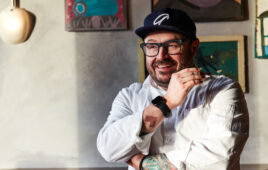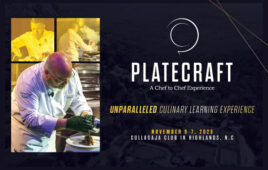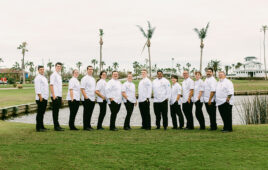
Anthony Lyons’ journey from the Emerald Isle into the world of U.S. club cuisine has brought him to Forest Hills CC, where he’s made an immediate impact by emphasizing consistency and service and drawing on his experience as an accomplished culinary coach.
Anthony Lyons, Executive Chef of Forest Hills Country Club in Chesterfield, Mo. (suburban St. Louis), first came to the U.S. in the early 1990s from a small village in County Tipperary in Ireland. His goal of becoming a top club chef eventually led him to the St. Louis area, where he’s worked his way up through culinary positions at several of the region’s leading private properties.
Last May, Chef Lyons moved to Forest Hills, known as one of the most family-friendly and innovative clubs in the area (see “Having a Blast,” C&RB, May 2009). Chef Lyons has already made an impact in his first few months at Forest Hills, as he’s helped to raise the club’s dining profile by ensuring greater food consistency and implementing a formal “Culinary Service” program. His considerable cooking skills, gained through being a coach of the St. Louis Junior Culinary Team for the American Culinary Federation, have also added an important component to the Forest Hills kitchen environment.
|
Anthony Lyons CHEF PROFILE
Current Position: Executive Chef, Forest Hills Country Club, St Louis, Mo. Previous Experience: |
We appreciate Chef Lyons taking time out in the middle of peak season, while still getting his bearings at his new club, to give his perspectives on what it really takes to make the culinary operation work at a full-service club.
Q Chef, you’ve come to know the St. Louis club scene pretty well now, having worked at many of the area’s best clubs over the past 15 years. What are you doing to combat the chain restaurants and other dining options that are in close proximity to Forest Hills, to try to keep your membership coming back on a daily basis for lunch and dinner?
A We have to keep a variety of menu options, with a large scope of ethnic offerings, and then provide them with value and service. We do this by running many different theme nights, promotions and menu samplings; for example, Italian Night, prime rib night, wine dinners and interactive wine club activities with food. And we are making sure to also offer different price points that can satisfy the various needs of the membership.
Q With Forest Hills being one of the premier family clubs in your region, how are you using the food and beverage program to enhance the swim and junior golf programs that are already thriving there?
A We have about 260 kids participating in junior golf, and a similar number in our swim program. When we have major swim meets we host large buffets, and also when we have large practices we put together breakfast and lunch programs. Our Forest Café caters to a very sizable pool crowd, predominately mothers and kids, throughout the summer months.
Q As the article in C&RB’s May issue described, your club has put a strong emphasis recently on using e-mail as a primary way to correspond with the members. What are the challenges involved with this for your department, as you try to reach everyone while marketing special club events?
A The jury is still out on this one, with it only having been since the start of the year since we’ve really put the emphasis on e-mail. So far we have had a very positive response, but there are some people who are still looking for a newsletter or flyer to help them know more about some activities and promotions. We try to supplement the e-mail blasts with a lot of promotion throughout the club—bulletin boards in locker rooms, poster boards, etc.
 |
| Forest Hills was opened in 1964 and now has 550 members. It has enhanced its strong golf reputation (with an 18-hole championship course and 9-hole executive course) by upgrading and expanding facilities and improving its culinary offerings; its 45,000-sq. ft. clubhouse can now handle banquets for 400. |
Q What rewards do you get from being an American Culinary Federation Junior Team coach?
A Coaching the team for our local chapter, the St. Louis Chefs de Cuisine, has the reward of seeing young cooks work hard towards the goal of becoming better at their craft. As for myself, through the teaching aspect I believe it makes one a better chef.
Q Overall, the amount of charity work that you do is exemplary. What advice can you give up-and-coming chefs about the importance of reaching out to the community through the culinary arts?
A Being a native of Ireland, we say “Charity begins at home.” Being involved in the community has many benefits; after all, giving is the best way to receive rewards. It can also help to promote not only yourself, but your business, in a very positive way.




